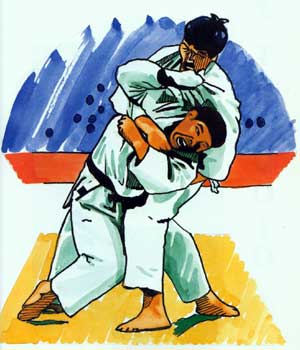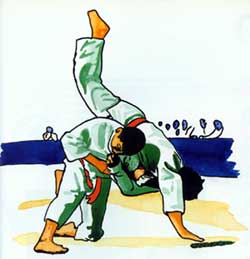
Questions Sent to the Judo Information SiteQ Sensei, I’ve been told that the “pistol grip” is no longer an approved technique in competition. Can you please tell me what the pistol grip is exactly and why it can no longer be applied. Ooohs! A The pistol grip is not allowed in IJF competition because it’s primarily a defensive position that is used to keep your opponent from attacking successfully. It is done by gripping the end of the opponent’s sleeve at the opening. It is usually done at the bottom of the sleeve under the opponent’s hand but can be above the wrist also. Grabbing the end of the sleeve with the fingers or thumb inside has long been illegal, but now if you grab the end of the sleeve with the fingers on one side and the thumb on the other (like a pistol) it is also penalized.
A I have just gotten over a stubbed big toe that I taped for about 3 months of practices. I have always found that taping works the best once you find a good way to do it. I start with an anchor strip around the toes and one around the sole of the foot. Then I connect the anchor strips with short pieces of 1 inch wide tape. Then I wrap the tape around starting at the big toe at a 45 degree angle to the outside of the anchor strip around the sole, continuing around the foot over the little toe and around again. Sometimes I will add one more anchor strip on the toes and the sole to hold the ends down. This combination of angles seems to work for me and the athletes I have taped. It adds some rigidity and limits the flexing of the toes, but that is what you want. Q Do you think Jigoro Kano knew more about judo than people do today? A Throughout Jigoro Kano’s lifetime Judo grew and changed dramatically. Since his death, Judo has continued to develop. Because of the tremendous popularity of Judo in so many countries around the world and because of the rigors of international competition, there are now techniques and practice methods that Kano Shihan had never conceived of. However it can still be said that no one alive today could have the same overall level of knowledge that the founder did, since he oversaw the growth of Judo to include the vast majority of the techniques, theory, training methods and principles used today. Q Dear Sir, A The answer is dojo, room or hall for practicing the way Q Hi my name is mike and i am learning how to break dance. There is one move in particular in break dancing where you jump from your feet and kick your legs in the air and land flat on your back, and to dissapate the force you smack your arms against the floor at the same time you hit with your back. I am having trouble getting the technique down and i was wondering if you could explain how to do it. Do i slap my arms down with my plams facing the floor or the back side of my hands facing the floor. Also what part of my back do i need to land on? if you could explain this to me or at least provide me with a site to where i could find this info i would greatly appreciate it. My dad studied the art of judo when he was younger and he told me of the judo technique of ‘falling’ and learning how to fall, so i believe by learning how to fall i can learn how to do this move. A OK Mike, you win the award for the best question I have gotten this year. I never thought I’d be giving break dancing advice but here goes. You are correct that Judo makes almost a science of falling. Here’s a web page with some information on falling techniques. Try to land on as much of your back as possible (flat). You should spread the force of the fall over as much of the back as possible. You are much more likely to get hurt if you land on only a part of your back. You try to relax to make your body land softer (can be accomplished through practice on mats). Be sure you are not holding your breath, exhale. Keep your head up, chin on the chest. Slap with your arms and hands, palms on the ground, at your side no more than a 45 degree angle from your body. The slap should be hard and your hands should bounce right back off the ground into the air. The slap is at the same time or just before the back hits. Q I also want to learn a certain judo takedown that has been utilized in rubgy in recent years to tackle oppents and place the ball on your teams side. i don’t know if i will have any luck. have you heard of this “rugby/judo takedown”? and if so do you know what the name of it is? A There are many Judo techniques that could be used successfully in rugby. Here is an answer from Iain Cunningham, 1st Dan (BJA) & Wing Forward (Jaguar RFC 1st XV): Q Love your site but when I checked the approved techniques I notice a technique that I have no info on. it is called Do-Jime. if there is anyway you could send me some info on this technique I would be really greatfull A Do jime is one of the Judo techniques not permitted in competition. It involves laying on the mat with uke between your legs and your feet locked together squeezing uke. This is called leg scissors here, and can be done on the head/neck as in a choking technique or more commonly on the trunk/ribs. Q I am some what confused as to how to properly write the names of throws and techniques. Are there rules of naming/writing the names? For example: Ogoshi or O-goshi or O-Goshi . . . Ippon Seoi Nage or Ippon-seoi-nage or Ippon seoinage . . .Hadaka Jime or Hadaka-Jime or Hadaka-jime etc. The same question for almost all throws and techniques. Please send me the rules and traditions so that I may be correct and consistant with most other traditional instructors. A Good question. I wish there were consistent rules but I don’t know of any. I see them different in almost every book. I try to separate the main parts (words or kanji characters) of each technique, but it is perfectly acceptable to run them together also. I don’t know of a technically accurate way to do it but I am not a language expert. Any of the variations you listed would be correct, and you should just try to be consistent with yourself. Q I am doing a comprehensive study on the greatest fighters of all-time. I’m looking for all types of information (bios, articles, books, profiles, fighting records (if applicable), height/weights, photos, etc.) If you could help me with any of this, I would greatly appreciate it. I’ve read some of your information that was posted on rec.martial-arts FAQ and I respect and admire your knowledge about the martial arts. I’m trying to be as objective as possible when it comes to different styles of fighting. I’m including fighters from all brands of martial arts, as well as boxing, wrestling, and ultimate fighting. I’m trying to differentiate between great martial arts masters and “actual” great combat fighters. AI don’t believe it is useful to compare different sports or martial arts based on who the greatest “fighter” is. The objective of Judo is not to develop the greatest fighter in the sense you are talking about. Comparing fighters who don’t use the same rules and who compete in different types of events is impossible, so I don’t think you can say who the greatest fighters are in an objective way without defining what you mean by a fighter. Q I am a new student, interested in finding out what the requirements are for different belts. I have tried to research this online myself, but cannot seem to find this particular information. If you could take a few minutes to let me know where I might find this, or answer it yourself, it would be most appreciated. A This question can’t be answered because it depends on:
The question should really be directed to your instructor, but each organization also publishes their requirements. You can get a copy of the requirements from whatever organization you belong to. Send your questions to . |
| I may venture to say, loosely, that in Judo there is a sort of counter for every twist, wrench, pull, push or bend. Only the Judo expert does not oppose such movements at all. No, he yields to them. But he does much more than yield to them. He aids them with a wicked sleight that causes the assailant to put out his own shoulder, to fracture his own arm, or in a desparate case, even to break his own neck or back. …..Lafcadio Hearn |  |

 Q Sir, I would lay a $50 that you have stubbed your individual toes, bent them under or backwards. We all know how good that feels. I’m having difficulty finding the right product or method of wrapping my toes. When I use tape it rolls up under my toes and during sparring when I slide my feet the tape comes off. Even cloth strips are prone to slip a strand off and then you’ve got a big spider web under your foot. Socks are great but you know the rules. Appealing to your nervous system, I am hoping you can suggest a method of securing my toes so that any impact is shared by several toes instead of just one. -rod
Q Sir, I would lay a $50 that you have stubbed your individual toes, bent them under or backwards. We all know how good that feels. I’m having difficulty finding the right product or method of wrapping my toes. When I use tape it rolls up under my toes and during sparring when I slide my feet the tape comes off. Even cloth strips are prone to slip a strand off and then you’ve got a big spider web under your foot. Socks are great but you know the rules. Appealing to your nervous system, I am hoping you can suggest a method of securing my toes so that any impact is shared by several toes instead of just one. -rod